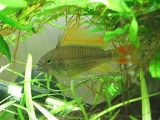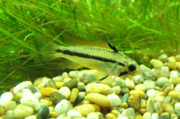
Apistogramma cacatuoides
Encyclopedia
Apistogramma cacatuoides is a species of South American cichlid
usually known under the common name cockatoo dwarf cichlid. Unlike many other Apistogramma species, A. cacatuoides is not threatened by extinction, as it is widely bred in captivity for the aquarium trade.
, Amazon
and Solimões
rivers from the Pachitea River to Tabatinga
in Peru
and Colombia
where it lives in small shallow streams or lagoon-like waters in the rain forest. The fish prefer a water temperature between 24 and 28 °C. The bottom of these waters is covered with leaves that are used by the fish for hiding.
One of the more interesting traits of Apistogramma cacatuoides is that of "sneaker" males. Due to the aggressive, territorial nature of the males, a submissive male will not develop the full "cockatoo" finnage nor the full male coloration. He will "pretend" to be a female and take any opportunities presented to mate with willing females. If the dominant male then dies, this submissive male will then develop the full finnage.
Small aquaria (less than 120 litres) should be avoided if more than a single pair is to be kept, as a female will protect an area of approximately 30 centimeters in radius. If breeding is to be attempted in a community aquarium, fast-swimming fish should be avoided as they will poach the fry from the female cacatuoides.
s.
Water conditions should be maintained in the pH 6.5-pH 8.0 range. These are one ofe the few South American Dwarf Cichlids that can tolerate alkaline water.

Cichlid
Cichlids are fishes from the family Cichlidae in the order Perciformes. Cichlids are members of a group known as the Labroidei along with the wrasses , damselfish , and surfperches . This family is both large and diverse. At least 1,300 species have been scientifically described, making it one of...
usually known under the common name cockatoo dwarf cichlid. Unlike many other Apistogramma species, A. cacatuoides is not threatened by extinction, as it is widely bred in captivity for the aquarium trade.
Characteristics
The male cockatoo dwarf cichlid reaches a body length of 8 centimetres. The female is considerably smaller, reaching only 5 centimetres. The body shape is long and of middle height and the mouth is rather big with thick lips. The male is more colorful than the female, usually with red/orange dorsal and caudal fins. The leading 3 or 4 hard rays are elongated, and the ventral fins are clear. In color, the female is quite dull but with a clear black line running along her flanks. Her background color is a pale yellow, but this will become vibrant when mating or brood protecting. In addition, she lacks the elongated dorsal rays of the male and her ventral fins show a black leading edge. There are several color forms which naturally occur in the wild; these include blues, yellows and some reds. Because of selective breeding the colors are now much more pronounced. Both sexes have a dark line leading from the eye to the bottom of the gill flap.Range and habitat
The cockatoo dwarf cichlid is found in the Amazon River basin, in tributaries of the UcayaliUcayali
The Ucayali River arises about north of Lake Titicaca, in the Arequipa region of South America. The Amazon River takes its name close to Nauta city , in the confluence among Ucayali and Marañón rivers....
, Amazon
Amazon River
The Amazon of South America is the second longest river in the world and by far the largest by waterflow with an average discharge greater than the next seven largest rivers combined...
and Solimões
Solimões
Solimões is the name often given to early stretches of the Amazon River from the border of Brazil and Peru to its confluence with the Rio Negro.Further upstream from the border, the name of the river seems to depend on the speaker...
rivers from the Pachitea River to Tabatinga
Tabatinga
Tabatinga is a municipality in the Três Fronteiras area of Northwestern Brazil. It is located in the Brazilian state of Amazonas. Its population was 45,293...
in Peru
Peru
Peru , officially the Republic of Peru , is a country in western South America. It is bordered on the north by Ecuador and Colombia, on the east by Brazil, on the southeast by Bolivia, on the south by Chile, and on the west by the Pacific Ocean....
and Colombia
Colombia
Colombia, officially the Republic of Colombia , is a unitary constitutional republic comprising thirty-two departments. The country is located in northwestern South America, bordered to the east by Venezuela and Brazil; to the south by Ecuador and Peru; to the north by the Caribbean Sea; to the...
where it lives in small shallow streams or lagoon-like waters in the rain forest. The fish prefer a water temperature between 24 and 28 °C. The bottom of these waters is covered with leaves that are used by the fish for hiding.
Breeding
The female places her eggs inside the roof of a cavity or underneath a leaf. She takes care of the eggs by herself, while the male guards the territory. The eggs are salmon colored.One of the more interesting traits of Apistogramma cacatuoides is that of "sneaker" males. Due to the aggressive, territorial nature of the males, a submissive male will not develop the full "cockatoo" finnage nor the full male coloration. He will "pretend" to be a female and take any opportunities presented to mate with willing females. If the dominant male then dies, this submissive male will then develop the full finnage.
Small aquaria (less than 120 litres) should be avoided if more than a single pair is to be kept, as a female will protect an area of approximately 30 centimeters in radius. If breeding is to be attempted in a community aquarium, fast-swimming fish should be avoided as they will poach the fry from the female cacatuoides.
Maintenance in the aquarium
The cockatoo dwarf is one of the best suited cichlid species for the planted aquarium. But because the male is highly territorial, the fish should be kept in pairs, trios (one male with two females), or harems (one male with many females), and in the company of peaceful tankmates like tetraTetra
thumb|right|250px|Pristella tetra — [[Pristella maxillaris]].thumb|right|250px|Golden Pristella tetra, a [[morph |morph]] of [[Pristella maxillaris]].thumb|right|250px|[[Silvertip tetra]] — Hasemania nana....
s.
Water conditions should be maintained in the pH 6.5-pH 8.0 range. These are one ofe the few South American Dwarf Cichlids that can tolerate alkaline water.

See also
- CichlidCichlidCichlids are fishes from the family Cichlidae in the order Perciformes. Cichlids are members of a group known as the Labroidei along with the wrasses , damselfish , and surfperches . This family is both large and diverse. At least 1,300 species have been scientifically described, making it one of...
- Dwarf cichlidDwarf cichlidDwarf cichlid is a term used by fishkeeping hobbyists to describe an arbitrary assemblage of small-sized fish from the family Cichlidae. Although the grouping is widely used in the aquarium industry and hobby, the grouping has no taxonomic or ecological basis and is poorly defined...
- ApistogrammaApistogrammaApistogramma is a genus of approximately a hundred species of fish from the family Cichlidae found in tropical areas of the Amazon basin and Venezuela. Apistogramma literally means "irregular lateral line" referring to a common trait of the species under this taxon...
- List of freshwater aquarium fish species

